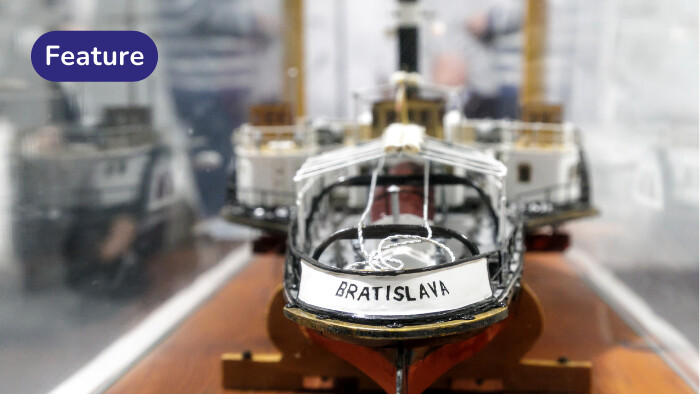One hundred years of Dunajplavba (Danube River transport company) with the subtitle Stories of Slovak ships on rivers, seas and oceans. This is the exhibition that visitors have the chance to see at the Bratislava Transport Museum until May 2024. It presents the history of shipping companies. In this show, we take a look not only at this exhibition, but also at history of Dunajplavba.
Dunajplavba_web Máte problém s prehrávaním? Nahláste nám chybu v prehrávači.
As the second longest European river, the Danube has served as a transport artery for centuries. It flows not only through Slovakia and its capital, but also through neighbouring Vienna in Austria, Budapest in Hungary crossing all together 10 countries.
Since the beginning of the 19th century, modern shipping has been developing on the Danube River. Ports in Bratislava, Komárno and Štúrovo were gradually established on the Slovak section of the Danube. After the collapse of the Austro-Hungarian monarchy, the “Czechoslovak Transport Authority” was established in Bratislava in 1919. It was the predecessor of the later shipping company "Československá akciová plavebná společnost dunajská" that turned one hundred in 2022. Since its establishment, the company’s name has changed several times. In 2024, it is called Slovenská plavba a prístavy or Slovak Navigation and Ports.
Which period was the most fruitful for the company was revealed to our colleague Martin Jurčo by Martin Goduš, a curator of the Bratislava Transport Museum.
“The golden era was the period after World War II. In 1948, it was enacted that only states through which the Danube flowed were allowed to conduct navigation business on the Danube. Until that year, countries such as England or Italy could do business on the river. With this resolution, they could no longer.”
Stanislav Drdoš, a former boatman, recalled the days when he worked for Dunajplavba or the Danube River transport company.
"I started working on the Danube in 1969, when I finished my military service. The Dunajplavba company had 70 river boats and 7 sea ships. It was quite complicated to get to the sea, because you had to pass exams and change to maritime transport. I managed it".
Stanislav Drdoš, a former boatman, sailed at sea on the naval ships called Lednice and Bojnice. These ships headed to the Mediterranean Sea, the Black Sea, the Suez Canal, the Red Sea and as far as Somalia and Eritrea. Czechoslovak production was exported and imported mainly to Eastern Bloc countries. Stanislav Drdoš tells our colleague Martin Jurčo what all was exported overseas.
„The goods were exported to so-called friendly countries that were part of the Council for Mutual Economic Assistance, an economic organisation led by the Soviet Union. Egypt, Libya or Morocco, for example. We transported building materials such as timber, which was needed in the Middle East. Then metallurgical materials. Škoda 120 cars were transported to Cyprus.“
For how long did the boatman Stanislav Drdoš go on voyages on the Danube and at sea?
“On the Danube, the journey was four to six weeks long from Bratislava to the sea and back. Then there was a break for about a week and then the journey again. At sea it was so that from embarkation to disembarkation was six months.”
Says Stanislav Drdoš. One hundred years of Dunajplavba with the subtitle Stories of Slovak ships on rivers, seas and oceans. This is the exhibition that visitors have the chance to see at the Bratislava Transport Museum until May 2024. It presents the history of shipping companies. There are ship models, photographs and information panels. This is only a part of the exhibition, about which the author Martin Goduš told our colleague Martin Jurčo.
“We also used the resources of the shipping company itself. They gave us machinery from the ships. For example, visitors can see the ship's bell, the steering wheel, the navigation lights or the anchors used over the last hundred years. You can also see the water filter that the boatmen used on the ships. Water was poured in, filtered through a stone and then used either for drinking or cooking.”
The exhibition also features period promotional materials, beacons, navigation devices and speed measuring equipment. Visitors can also find a telegraph machine, which was used in the wheelhouse. Martin Goduš.
“It was used for communication between the wheelhouse and the engine room. The helmsman has given a command to the engineer via the telegraph. For example, stop, attention, full speed, etc. The engineer executes the command and sends an acknowledgement back to the helmsman.”
An interesting feature of the Danube River is that its length is measured not from its source, but from its mouth to the sea. At the exhibition in the Bratislava Transport Museum, visitors are guided by former boatman Stanislav Drdoš. He worked on the tugboat Šturec, the oldest preserved ship in Slovakia.
"It's very interesting for people because the job of a boatman is not for everyone. The museum staff chose me as a guide because they have worked with me in the past. I like doing this because I enjoy the subject and I like to share the information I have. I used to work on the tugboat Šturec as an engineer's assistant, then as a machinist. Currently, the Šturec is on display in the harbour and is open to the public twice a year. The exhibition is also visited by foreign tourists. We have had a positive response to this exhibition."
Stanislav Drdoš concludes. Those who are interested can visit the exhibition dedicated to the 100 years of Dunajplavba by the 15th of May 2024. Moreover, in May 2024, the European Network of River Museums Conference will be held in the Bratislava Transport Museum.
This article was originally published on 15th of January, 2024. It was updated on 25th of March, 2024.

